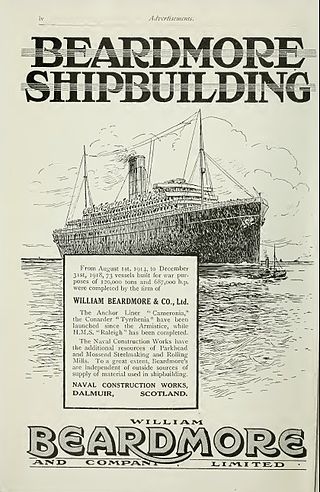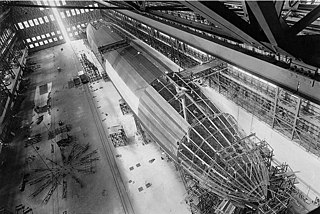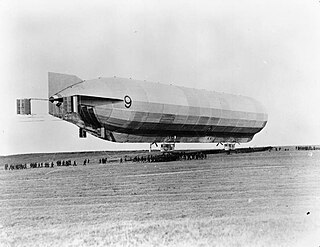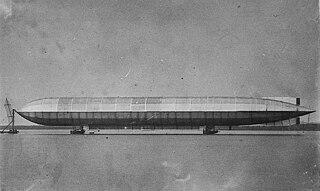
Vickers was a British engineering company that existed from 1828 until 1999. It was formed in Sheffield as a steel foundry by Edward Vickers and his father-in-law, and soon became famous for casting church bells. The company went public in 1867, acquired more businesses, and began branching out into military hardware and shipbuilding.
Vickers-Armstrongs Limited was a British engineering conglomerate formed by the merger of the assets of Vickers Limited and Sir W G Armstrong Whitworth & Company in 1927. The majority of the company was nationalised in the 1960s and 1970s, with the remainder being divested as Vickers plc in 1977.

Vickers Shipbuilding and Engineering, Ltd (VSEL) was a shipbuilding company based at Barrow-in-Furness, Cumbria in northwest England that built warships, civilian ships, submarines and armaments. The company was historically the Naval Construction Works of Vickers Armstrongs and has a heritage of building large naval warships and armaments. Through a complicated history the company's shipbuilding division is now BAE Systems Submarine Solutions and the armaments division is now part of BAE Systems Land & Armaments.
Armstrong Siddeley was a British engineering group that operated during the first half of the 20th century. It was formed in 1919 and is best known for the production of luxury vehicles and aircraft engines.

Sir W G Armstrong Whitworth & Co Ltd was a major British manufacturing company of the early years of the 20th century. With headquarters in Elswick, Newcastle upon Tyne, Armstrong Whitworth built armaments, ships, locomotives, automobiles and aircraft.

His Majesty's Airship R100 was a privately designed and built British rigid airship made as part of a two-ship competition to develop a commercial airship service for use on British Empire routes as part of the Imperial Airship Scheme. The other airship, the R101, was built by the British Air Ministry, but both airships were funded by the Government.
Metropolitan-Vickers, Metrovick, or Metrovicks, was a British heavy electrical engineering company of the early-to-mid 20th century formerly known as British Westinghouse. Highly diversified, it was particularly well known for its industrial electrical equipment such as generators, steam turbines, switchgear, transformers, electronics and railway traction equipment. Metrovick holds a place in history as the builders of the first commercial transistor computer, the Metrovick 950, and the first British axial-flow jet engine, the Metropolitan-Vickers F.2. Its factory in Trafford Park, Manchester, was for most of the 20th century one of the biggest and most important heavy engineering facilities in Britain and the world.

Wolseley Motors Limited was a British motor vehicle manufacturer founded in early 1901 by the Vickers Armaments in conjunction with Herbert Austin. It initially made a full range, topped by large luxury cars, and dominated the market in the Edwardian era. The Vickers brothers died and, without their guidance, Wolseley expanded rapidly after the war, manufacturing 12,000 cars in 1921, and remained the biggest motor manufacturer in Britain.

John Davenport Siddeley, 1st Baron Kenilworth, was a pioneer of the motor industry in the United Kingdom, manufacturing aero engines and airframes as well as motor vehicles.

William Beardmore and Company was a British engineering and shipbuilding conglomerate based in Glasgow and the surrounding Clydeside area. It was active from 1886 to the mid-1930s and at its peak employed about 40,000 people. It was founded and owned by William Beardmore, later Lord Invernairn, after whom the Beardmore Glacier was named.

The R.80 was a British rigid airship, first flown on 19 July 1920, and was the first fully streamlined airship to be built in Britain. Originally a military project for the British Admiralty, it was completed for commercial passenger-carrying. R.80 proved too small for this role and after being used briefly to train the United States Navy personnel who were to crew the ZR-2 airship, R.80 was retired and eventually scrapped in 1925.

A rigid airship is a type of airship in which the envelope is supported by an internal framework rather than by being kept in shape by the pressure of the lifting gas within the envelope, as in blimps and semi-rigid airships. Rigid airships are often commonly called Zeppelins, though this technically refers only to airships built by the Luftschiffbau Zeppelin company.

The 23 class were rigid airships produced in the United Kingdom during the First World War. Development of the 23 class began in August 1915 when Vickers was asked to improve the 9r design by increasing its gas capacity by adding a bay and increasing the capacity of the bow and stern gas cells. The 23-class was designed by H.B. Pratt and Barnes Wallis of Vickers. Vickers built the first and last of the four ships. The other two were built by William Beardmore and Company and Armstrong-Whitworth. While the 23 class airships were never used in combat, the four ships provided many hours of valuable training and experimental data for British airship crews and designers. Although a total of 17 of these ships were contemplated at one time, only four were ever built. The 23 class was found to be significantly overweight, leading to its cancellation in favour of the more-refined R23X class.

HMA No. 9r was a rigid airship designed and built by Vickers at Walney Island just off Barrow-in-Furness, Cumbria. It was ordered in 1913 but did not fly until 27 November 1916 when it became the first British rigid airship to do so. It was dismantled in June 1918 after being flown for around 165 hours, mainly for experimental purposes.

Vickers plc was the remainder of Vickers-Armstrongs after the nationalisation of three of its four operating groups: aviation, shipbuilding and steel. It was purchased by Rolls-Royce plc in 1999, and the Vickers company name became defunct in 2003 as Rolls renamed the company Vinters Engineering.
Vickers is a famous name in British engineering that existed through many companies starting in 1826.
Canadian Vickers Limited was an aircraft and shipbuilding company that operated in Canada during the early part of the 20th century until 1944. A subsidiary of Vickers Limited, it built its own aircraft designs as well as others under licence. Canadair absorbed the Canadian Vickers aircraft operations in November 1944.

Coventry Ordnance Works was a British manufacturer of heavy guns particularly naval artillery jointly owned by Cammell Laird & Co of Sheffield and Birkenhead, Fairfield Shipbuilding and Engineering Company of Govan, Glasgow and John Brown & Company of Clydebank and Sheffield. Its core operations were from a 60-acre site in Stoney Stanton Road in the English city of Coventry, Warwickshire.

The Maxim-Nordenfelt Guns and Ammunition Company was the result of a takeover by Hiram Maxim of Thorsten Nordenfelt's Nordenfelt Guns and Ammunition Company in 1888. Rothschild issued £1.9 million of shares to finance the merger. Nathan Rothschild retained a substantial shareholding in the new Maxim-Nordenfelt combine and ‘exerted a direct influence over its management’.

His Majesty's Airship No. 1 was designed and built by Vickers, Sons and Maxim at their works in Barrow-in-Furness, Lancashire, England, as an aerial scout airship for the Royal Navy. It was the first British rigid airship to be built, and was constructed in a direct attempt to compete with the German airship programme. Often referred to as "Mayfly", a nickname given to it by the lower deck, in public records it is designated 'HMA Hermione' because the naval contingent at Barrow were attached to HMS Hermione, a cruiser moored locally preparing to act as its tender.


















